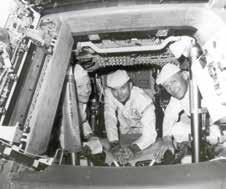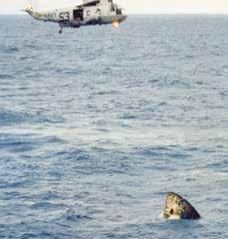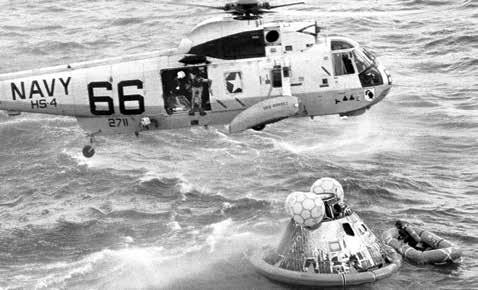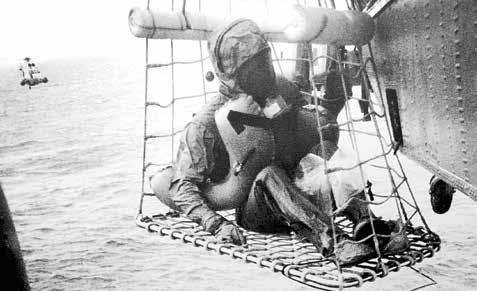
5 minute read
SPLASH DOWN!
Mission accomplished for Coronado Underwater Demolition Team's safe recovery of Apollo 11 astronauts

Advertisement
Story by DON CRAWFORD Photos courtesy U.S. NAVY & NASA
In the midst of the space race with the Soviet Union, President John
F. Kennedy set a goal of landing a man on the moon and bringing him home safely by the end of 1969. For eight days in July 1969, the world stood mesmerized by NASA’s moon launch of Apollo 11 and the historic first moon walk by Neil Armstrong and Buzz Aldrin.
The second part of Kennedy’s challenge was the safe recovery of the astronauts. The most crucial tasks of the recovery were accomplished by members of Underwater Demolition Team Eleven (UDT-11) stationed at the Naval Amphibious Base Coronado.
The recovery of the Apollo 11 Command Module included members of UDT-11 and UDT-12 in a detachment known as UDT Det Apollo, helicopters from HS-4 “Black Knights” stationed in Imperial Beach and small boats from the aircraft carrier USS Hornet, the primary recovery ship.
Apollo 11 astronauts in BIG suits with red water wing life vests await retrieval as HS-4 Sea King Helicopter #64 from the USS Hornet approaches.


Crew conducts check of Apollo 11 Command Module. From left, Neil Armstrong, commander; Michael Collins, Command Module pilot; and Buzz Aldrin, Lunar Module pilot.
TRAINING EXERCISES
Neil Armstrong took this photograph of Buzz Aldrin and the U.S. flag on the lunar surface. Astronaut footprints are clearly visible in the soil of the moon.

Members of UDT Det Apollo, HS-4, and USS Hornet conduct recovery of Command Module boilerplate during a Simulated Recovery Exercise (SIMEX) to perfect recovery procedures.
STABLE 2 STABLE 1
The recovery consisted of four steps: Find, Stabilize, Remove and Retrieve. UDT Det Apollo’s mission included the last three steps.
Because of the importance of the mission, competition among Underwater Demolition Team members was intense and only the very best “Frogmen” were chosen. The final team consisted of three Swim Teams of three members each, two Biological Isolation Garment (BIG) swimmers and a corpsman. Swim Team 2 with LTjg Wesley T. Chesser, Petty Officer 3rd Class Michael G. Mallory and Seaman John Michael Wolfram was designated as the primary recovery team by the detachment’s commander, LT Clancy Hatleberg.
To ensure realistic training of the recovery tasks, NASA provided a replica, known as a boilerplate, of the Command
After splashdown, the Apollo 11 astronauts initiated the buoy system to bring the Command Module Columbia from the upsidedown (Stable 2) to the right-side up (Stable 1) position ready for recovery.


With the sea anchor and flotation collar attached and inflatable rafts positioned, LT Clancy Hatleberg, the BIG swimmer, prepares to jump from an HS-4 helicopter to join UDT Swim Team 2 members and begin the decontamination process.
Module. Numerous training exercises in Coronado and off the Hawaiian Islands ensured the detachment was prepared.
After eight days in space, Apollo 11 splashed down in the Pacific Ocean southwest of Hawaii at 5:49 a.m. on July 24. After the detachment of the parachutes, the module floated upside down (Stable 2 position). The astronauts activated the flotation system, which brought the module to the upright position (Stable 1) necessary for recovery, as the helicopter with Swim 2 arrived.
The STABILIZE portion of the recovery consisted of two tasks: attaching a sea anchor to slow the drift of the module and attaching a flotation collar to further stabilize the module so it wouldn’t sink. At 5:58 a.m., Wolfram, the strongest swimmer in the group, jumped from the helicopter and attached and deployed the sea anchor. Two minutes later, Chesser and Mallory entered the water and attached and inflated the flotation collar in three minutes.
Two rafts were dropped from the helicopter to initiate the REMOVE task. Concern over possible moon pathogens required Hatleberg to disinfect the module and astronauts prior to retrieving them.
Hatleberg arrived and threw three BIG suits into the module. These garments would keep the astronauts properly quarantined, if they had been infected. Once dressed, the astronauts were removed from


After removal from the Command Module to an inflatable raft, Apollo 11 astronauts, wearing BIG suits, begin the decontamination process of the exteriors of their suits.
the module and taken on board one of the rafts. Hatleberg disinfected the outside of the module with betadine and the outside of each suit with sodium hypochlorite.
The RETRIEVE task began with a HS-4 helicopter lifting the astronauts via a basket-like Billy Pugh net. Once onboard, the helicopter departed for the Hornet at 6:53 a.m. The entire recovery was completed in less than one hour. Swim 2 remained with the module and assisted in attaching a crane hook to lift it on board the Hornet.
The professionalism, skill and initiative demonstrated by UDT Det Apollo were characteristic of the Navy Frogmen and were instrumental to the successful recovery of America’s most famous astronauts. • Don Crawford is a former Navy SEAL and Frogman and was a member of SEAL Team One and UDT-12
Apollo 11 astronaut Neil Armstrong, wearing his BIG suit, is being hoisted via a Billy Pugh net into the cargo hatch of Sea King #66. A stand-by helicopter with UDT Swim Team 1 aboard is seen in the background.








